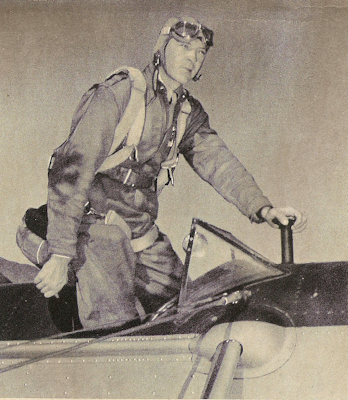In the early 1900s, airplanes were not just a novelty. They were a marvel, almost a miracle, and flying in one was the dream of every American boy and girl. Hoosiers figured prominently in those pioneering years of aviation. Not least among Indiana pilots of course was Wilbur Wright, born in 1867 near Millville, Indiana. Before the turn of the century, Wilbur and his Ohio-born brother Orville set up a bicycle shop in Dayton, Ohio. In 1903, they flew an airplane of their own design and manufacture at Kill Devils Hill in North Carolina, thus launching not only their small Flyer, but also the Age of Aviation. The story of the brothers' success and their proximity to Richmond, Indiana, must have been a powerful draw for a young boy growing up there. At age twelve, future pilot and artist Reed Kinert began collecting material on aircraft and aviation, thus beginning a life devoted to things with wings.
Born on August 31, 1911, Reed Charles Kinert attended schools in his hometown before setting off for studies at the College of Los Angeles. In 1932, Kinert learned to fly in Richmond by taking lessons from a barnstorming pilot. He operated the airport in Richmond and worked as a weather observer at the nearby Centerville Airport before becoming a barnstorming pilot of the 1930s. He also began creating illustrations for collectors and for the Vought and Aeronca aircraft companies. Between 1933 and 1947, Kinert was a flight instructor and test pilot. As an artist, Kinert designed insignia for two Navy bomber squadrons and worked as an illustrator and cartoonist for United Aircraft Corporation of America, and Beechcraft Aircraft. He also served as art director for the Aerospace Division of Librascope, Inc.
Kinert attended nearly every National Air Race beginning in 1929 and put his experiences to good use in his book, American Racing Planes and Historic Air Races (1952). He was an air racer himself for some time. Kinert wrote and illustrated books on aviation for much of his career, including his four-volume Racing Planes and Air Races: A Complete History (1967-1969). Other titles included America’s Fighting Planes in Action (1943), Our Fighting Planes: The Story of U.S. Military Aircraft of World War II (1946), and Little Helicopter (1947). His Early American Steam Locomotives: First Seven Decades, 1830-1900 (1962) was awarded a non-fiction prize by Indiana University in 1963.
In his author's note for Our Fighting Planes, published immediately after World War II, Kinert expressed feelings about flight that justify a long quotation:
Flight is the expression of spiritual achievement, the antithesis of the worn shoe and the weary foot. Flight is the opposite course to the rocky road, the long climb and the dusty plain and is the answer to an ageless human longing to see what is over the hill. In religion, they call it the instinct to immortality. With flight, peoples can battle loneliness and separation and isolation and bigotry and prejudice. With flight, free men will become more free. . . . In these pages I have made no attempt to glorify war, only flight itself, for war is hell.
Reed Kinert died on September 9, 1976, in San Diego, California. This year marks his centennial, observed here if nowhere else.
 |
Pilot, aviation enthusiast, and artist Reed Kinert of Richmond, Indiana.
|
Captions and text copyright 2011, 2024 by Terence E. Hanley


Reed Kinert would have been my father in-law. I never had the privilege of meeting him. I married his daughter after his death. He lives in many documented celebrations of his love for planes and railroads that surround me. In his later life he was a prolific painter and many of his paintings along with some he traded with other artist, line the walls of our home. Among these are many of his original illustrations that were reproduced in his published works. Unfortunately, many of the illustrations from the warplane series (including the one’s you have published here) were destroyed in a museum fire.
ReplyDeleteOther places Reed Kinert “hung his hat”…
* Ryan Aeronautical Company later became Teledyne Ryan and later still, Northrop Grumman
* Singer Kearfott Aeronautics
* He also taught pilot cadets in Hemet California during WWII at Ryan School of Aeronautics.
Thanks for the information, Sam. It's a tragedy that his artwork was destroyed, but at least we can still see it in print.
ReplyDeleteI have seen reference to Reed Kinert having been a cartoonist, but I haven't found any reproductions anywhere. I wonder if you know anything about that.
I grew up with "America's Fighting Planes in Action" as my father had the original hardcover 1943 edition. I spent many a rainy day as a youth in the 60's reading his aircraft descriptions and studying his colorful and well done illustrations. I just ordered what appears to be an original edition of this book on Amazon for a reasonable price. Looking forward to it and may Mr. Kinert Rest In Peace.
ReplyDeleteHi, Dank,
DeleteThanks for your childhood memories of reading Reed Kinert's books.
I'll ask again that all commenters refrain from leaving commercial messages on my blog. I don't want to see any brandnames, nor do I want to know where you have bought anything, will buy anything, or can buy anything. This may sound like I'm singling you out, Dank, but I'm not. I would just like for people to discuss books, authors, artists, and ideas without getting into commerce. I have not monetized my blog for very good reasons, and I ask that everyone else refrain from trying to monetize it as well.
Thank you.
Terence Hanley
This comment has been removed by the author.
ReplyDelete